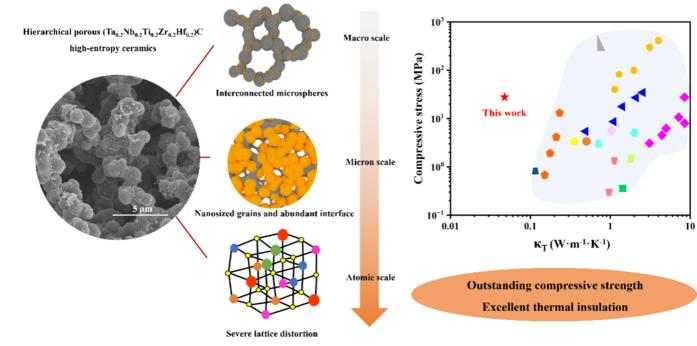Reviewed by Lexie CornerJul 23 2024
A group of material scientists from Shaanxi University of Science and Technology in China, led by Haibo Ouyang, described the creation, microstructure, compressive strength, and thermal conductivity of the porous (Ta0.2Nb0.2Ti0.2Zr0.2Hf0.2) C high-entropy ceramics using a self-foaming technique. This research was published in the Journal of Advanced Ceramics on May 6th, 2024.
 The porous (Ta0.2Nb0.2Ti0.2Zr0.2Hf0.2)C high-entropy ceramic possesses interconnected microspheres, abundant interface in the microspheres, and the severe lattice distortion of the high-entropy ceramics, leading to their excellent properties in mechanical and thermal insulation. Compared to other reported porous UHTCs, the obtained PHEC ceramic shows remarkable mechanical and thermal properties. Image Credit: Journal of Advanced Ceramics, Tsinghua University Press
The porous (Ta0.2Nb0.2Ti0.2Zr0.2Hf0.2)C high-entropy ceramic possesses interconnected microspheres, abundant interface in the microspheres, and the severe lattice distortion of the high-entropy ceramics, leading to their excellent properties in mechanical and thermal insulation. Compared to other reported porous UHTCs, the obtained PHEC ceramic shows remarkable mechanical and thermal properties. Image Credit: Journal of Advanced Ceramics, Tsinghua University Press
Thermal insulation material is an essential part of the thermal protection system (TPS) of hypersonic vehicles. High-entropy ceramics have recently received considerable attention in thermal insulation due to their low thermal conductivity caused by phonon scattering by many components and deformed lattices.
Porous high-entropy carbide (PHEC) ceramics have emerged as attractive TPS candidates due to their intrinsic qualities, such as a high melting point, outstanding high-temperature stability, low density, and exceptional thermal insulation.
Porous high-entropy carbide ceramics have been produced utilizing various techniques, including template, direct foaming, and partial sintering. Metal carbides or oxides are typically employed as starting materials for the solid-state synthesis of these ceramics. Extensive milling is required to distribute the different components, as well as extremely high processing temperatures to accelerate atom diffusion.
However, this method is energy-intensive and adds contaminants to the ball milling process, destroying stoichiometry and influencing configurational entropy. Furthermore, high-temperature sintering causes grain formation and eliminates nanosized pores, making it difficult to control the porosity and pore structure of the PHEC ceramic. This solid-state technique also limits the molding and processing of high-entropy carbides.
This study offers a facility- and cost-effective method for producing porous ultrahigh-temperature ceramics. It also explains the formation mechanism of the distinct hierarchical porosity structure and superior compressive and thermal insulation properties of the porous (Ta0.2Nb0.2Ti0.2Zr0.2Hf0.2) C high-entropy ceramics.
In this report, we synthesized the porous (Ta0.2Nb0.2Ti0.2Zr0.2Hf0.2) C high-entropy ceramics by a self-foaming method using commercially available metal chloride and furfuryl alcohol as the precursor. This method was inspired by the self-foaming behavior of FA. The polymer foam that contains elements like Ti, Zr, Ta, Nb, and Hf can be produced by the self-condensation of FA using metal chlorides as catalysts. The polymer foam transformed into porous ceramics through pyrolysis and carbothermal reduction processes.
Haibo Ouyang, Professor, School of Materials Science and Engineering, Shaanxi University of Science and Technology
Ouyang is a specialist whose research interests include ultra-high-temperature ceramics and composites.
Ouyang added, “The PHEC ceramic is constructed by microspheres with a size of 2 µm, leading to a high porosity of 91.3% and an interconnected frame. These microspheres consist of high-entropy carbide grains (20 nm), resulting in abundant interface and nanosized pores in the PHEC ceramic.”
“Due to its unique hierarchical structure, the prepared PHEC ceramic has outstanding compressive strength (28.1±2 MPa) and exceptionally low thermal conductivity at room temperature (0.046 W·m−1·K−1). This makes it a promising thermal insulation material in ultrahigh temperature application,” Ouyang stated.
Further careful investigation is still required to investigate the oxidation resistance of the porous (Ta0.2Nb0.2Ti0.2Zr0.2Hf0.2) C high-entropy ceramics as a novel thermal insulation material. Ouyang also presented two significant works in this area: the mechanical characteristics at high temperatures and the resistance to oxidation and ablation in ultrahigh temperatures.
The other contributors are Cuiyan Li, Ruinan Gao, Tianzhan Shen, Zihao Chen, and Yanlei Li from the School of Materials Science and Engineering at Shaanxi University of Science and Technology, China.
The study was supported by the National Natural Science Foundation of China (Nos. 52173299 and 52372087) and the Natural Science Foundation of Shaanxi Province (No. 2021JZ-51).
Journal Reference:
Li, C., et. al. (2024) Hierarchical porous (Ta0.2Nb0.2Ti0.2Zr0.2Hf0.2) C high-entropy ceramics prepared by a self-foaming method for thermal insulation. Journal of Advanced Ceramics. doi:10.26599/JAC.2024.9220909